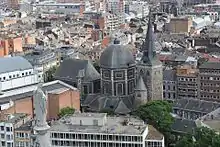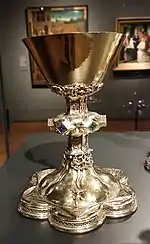Church of St John the Evangelist, Liège
The Church of St John the Evangelist (French: église Saint-Jean l'Evangéliste) in the city of Liège, Belgium, was founded as a collegiate church by Notker of Liège around 980, and consecrated in 987. It was the place of Notker's tomb. The church was suppressed in 1797 during the French Revolution, the building being confiscated and sold in 1798.

On 23 March 1879, Pope Leo XIII canonically crowned the statue of Saint Joseph within this shrine, in honor of the 200th anniversary of the request by King Charles II of Spain to Pope Innocent XI to consecrate Belgium to Saint Joseph. The coronation feast also coincided with the 203rd anniversary of Diocese of Liege by request of Emperor Leopold I in 1676 and approved by Pope Clement X. The image was consequently lost to history during the First World War, its is whereabouts unknown. The notarized Pontifical decree was received by Bishop of Liege, Victor Doutreloux.
Originally an octagonal building in Mosan Romanesque style, incorporating elements of the Church of the Holy Sepulchre in Jerusalem,[1] the church was completely rebuilt in a late Baroque style in 1754–1784.[2] It has been in use as a parish church since 1809, and has been listed as a monument since 1952.[3]


The church maintained a library from 1388.[4]
The Renaissance composer Johannes Brassart was closely associated with the church.[5]
See also
References
- Kathryn Blair Moore, The Architecture of the Christian Holy Land (Cambridge University Press, 2017), p. 61.
- E. Den Hartog, Romanesque Architecture and Sculpture in the Meuse Valley (Mechelen, 1992), p. 41.
- Heritage listing, accessed 29 May 2017.
- Albert Derolez, Corpus Catalogorum Belgii: The Medieval Book Lists of the Southern Low Countries, vol. 2, Provinces of Liège, Luxemburg and Namur (Brussels, 1994).
- Catherine Saucier, A Paradise of Priests: Singing the Civic and Episcopal Hagiography of Medieval Liège (University of Rochester Press, 2014), p. 153.